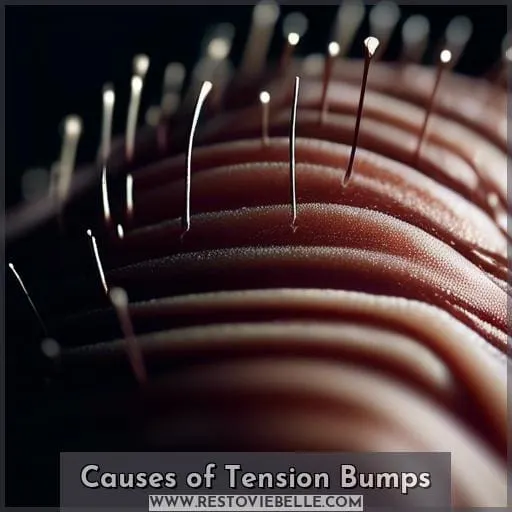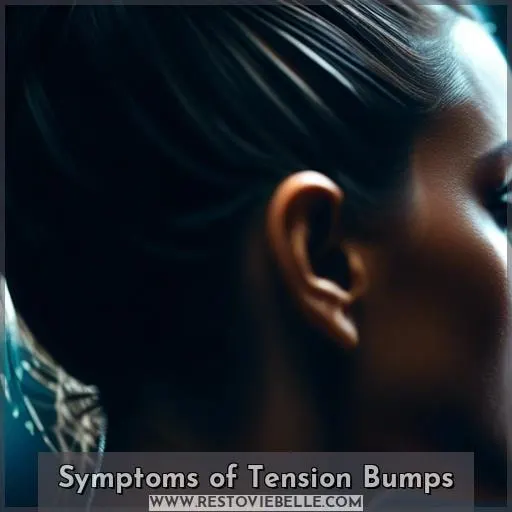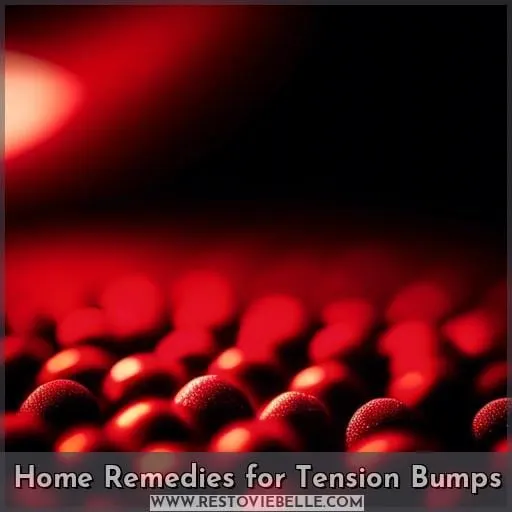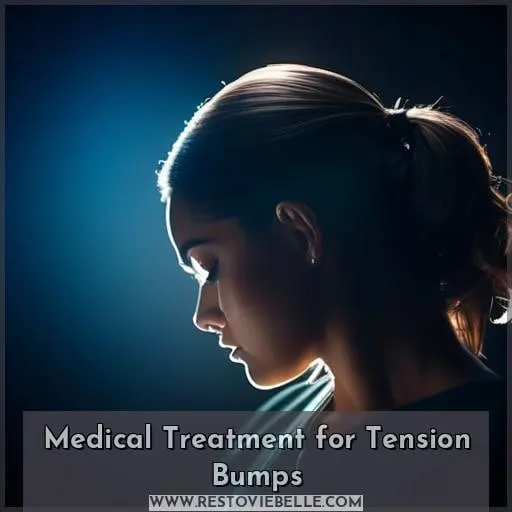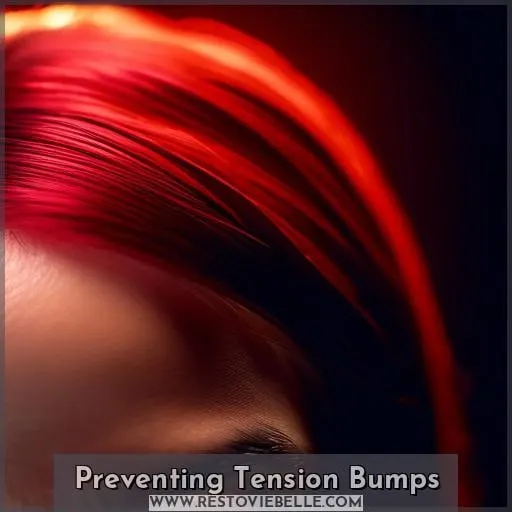This site is supported by our readers. We may earn a commission, at no cost to you, if you purchase through links.
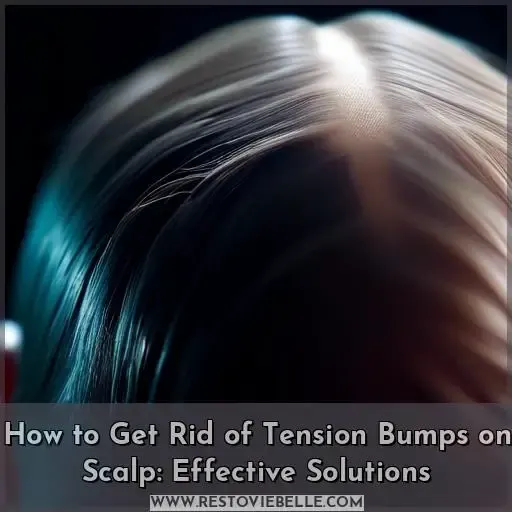 Nearly 50% of women who frequently wear tight hairstyles experience traction alopecia, leading to tension bumps on the scalp.
Nearly 50% of women who frequently wear tight hairstyles experience traction alopecia, leading to tension bumps on the scalp.
If you’re struggling with these irritating bumps, you’re not alone. There are effective solutions to soothe your scalp and prevent further damage.
This guide will explore the causes, symptoms, and both home and medical treatments to help you regain a healthy, bump-free scalp.
Let’s tackle those tension bumps and restore your comfort and confidence.
Yes, you can get rid of tension bumps on your scalp by using effective solutions. These remedies can help alleviate the discomfort and reduce the appearance of these bumps.
Table Of Contents
- Key Takeaways
- Causes of Tension Bumps
- Symptoms of Tension Bumps
- Home Remedies for Tension Bumps
- Medical Treatment for Tension Bumps
- Preventing Tension Bumps
- Frequently Asked Questions (FAQs)
- Can certain hair care products exacerbate tension bumps on the scalp?
- How can I differentiate between tension bumps and other scalp conditions like psoriasis or cysts?
- Are there any dietary changes that can help alleviate tension bumps on the scalp?
- Can stress contribute to the development of tension bumps, and if so, how can it be managed?
- Is it safe to dye or chemically treat hair that is prone to tension bumps, and what precautions should be taken?
- Conclusion
Key Takeaways
- Tight hairstyles like braids and ponytails can increase the risk of developing tension bumps due to follicle infection and chemical irritation from synthetic extensions and hair products.
- Symptoms of tension bumps include small red bumps, an itching or burning sensation, and sometimes pus-filled sores.
- Home remedies such as warm compresses, antibacterial soap, topical antibiotic ointments, anti-fungal shampoo, and lightweight oil massages can be effective in treating tension bumps.
- To prevent tension bumps, it’s recommended to practice gentle scalp massages, use a satin bonnet at night, monitor hair shedding, apply hair oils for moisture, and choose gentle hair care products.
Causes of Tension Bumps
When it comes to tension bumps on the scalp, it’s crucial to understand the root causes to effectively address and prevent them.
Tight hairstyles, such as braids or ponytails, can put excessive tension on hair follicles, leading to damage and the risk of follicle infection.
Additionally, the use of certain chemicals in hair products or extensions can irritate the scalp, further exacerbating the issue.
Tight Hairstyle Damage
Tight hairstyles, such as braids, can lead to tension bumps on the scalp, a form of scalp folliculitis. This condition arises when hair follicles become inflamed due to excessive pulling and tension, potentially leading to infection.
- Use loose braids to minimize tension and avoid hair breakage.
- Apply a hair mask regularly to nourish and strengthen hair.
- Wear a night bonnet to protect your hair while sleeping, reducing the risk of damage.
- Sleep on a silk pillowcase to reduce friction and prevent scalp damage.
Incorporating these practices into your hair care routine can help prevent tension bumps and promote overall scalp health.
Follicle Infection Risk
Moving on from the damage tight hairstyles can inflict, it’s crucial to understand the risk of follicle infection.
When your scalp is under constant tension from styles like tight braids or ponytails, it’s not just the hair that suffers. This undue stress can lead to follicle inflammation, a precursor to more serious issues like bacterial infection.
If bacteria invade these compromised follicles, the result can be painful, pus-filled bumps known as tension bumps. Moreover, such conditions can exacerbate scalp sensitivity and contribute to hair breakage.
In severe cases, this cycle of damage and infection can even lead to antibiotic resistance, complicating treatment. It’s a stark reminder of the importance of scalp care and the need to mitigate tension alopecia through mindful hairstyling practices.
Chemical Irritation Concerns
When transitioning from the topic of follicle infection risk to chemical irritation concerns, it’s crucial to understand how synthetic extensions and certain hair products can exacerbate scalp issues.
Synthetic extensions, while cost-effective, often come with a chemical coating that can irritate the scalp, leading to discomfort and potentially contributing to hair loss. This is particularly concerning for those who opt for protective styles as a means of hair care.
To mitigate these risks, it’s advisable to choose plant-based or human hair extensions, which are less likely to cause irritation.
Products containing natural ingredients like tea tree oil or aloe can soothe the scalp and prevent the dryness that often accompanies chemical irritation. By being mindful of the materials and products used in your hair care routine, you can protect your scalp from unnecessary stress and promote healthier hair growth.
Symptoms of Tension Bumps
If you’re noticing small red bumps, an itching or burning sensation, or pus-filled sores on your scalp, these could be symptoms of tension bumps.
These bumps are often a result of tight hairstyles that pull on the hair follicles and scalp, leading to irritation and inflammation.
It’s important to address these symptoms promptly to prevent further discomfort and potential infection.
Small Red Bumps
If you’re experiencing small red bumps on your scalp, it’s likely a sign of scalp sensitivity or irritation. These bumps can be caused by various factors, including tight hairstyles like updos that pull on the hair follicles, poor scalp hygiene, or an adverse reaction to hair care products.
To maintain scalp health and prevent braid damage, it’s important to adopt a gentle hair care routine. This should include using proper braiding techniques to avoid excessive tension and choosing hairstyles that don’t pull on the scalp, such as looser braids or twists.
To alleviate an itchy scalp and reduce the appearance of bumps, consider incorporating natural ingredients into your scalp care, such as tea tree oil, which has antibacterial properties. Regularly moisturizing the scalp with products containing soothing ingredients like aloe or jojoba oil can also help.
If you notice persistent or worsening symptoms, it’s crucial to consult a healthcare professional for appropriate treatment, which may include medicated shampoos or topical ointments. Remember, taking care of your scalp is as important as taking care of your hair, so be mindful of the signs your body gives you and adjust your hair care routine accordingly.
Itching/Burning Sensation
If you’re experiencing itching and burning sensations along with small, raised bumps on your scalp, these could be symptoms of tension bumps, commonly known as braid bumps.
These uncomfortable sensations are often a result of tight hairstyles that pull on the hair follicles, causing tension and inflammation. To alleviate the discomfort, it’s important to release any excessive tension by opting for looser hairstyles and avoiding styles like long braids that can exacerbate the issue.
Regular treatment with soothing products containing ingredients like tea tree or peppermint oil can help. If the bumps are persistent or worsening, applying an antibacterial ointment may provide relief.
For ongoing care, ensure you’re maintaining proper scalp hygiene and hydration, and consider using a lightweight oil to massage the area gently. If symptoms persist, seek medical advice as you may require a prescription antifungal cream or oral antibiotics.
Pus-Filled Sores
Pus-filled sores are distressing symptoms of tension bumps on the scalp. To address this issue effectively, consider the following:
- Gentle Cleansing: Use mild antibacterial soap to clean the affected area.
- Antibiotic Ointment: Apply a thin layer of Neosporin to promote healing.
- Avoid Scratching: Refrain from scratching to prevent further irritation.
- Hydration: Keep your scalp moisturized with products containing soothing ingredients like tea tree oil.
Home Remedies for Tension Bumps
After discussing the discomforting symptoms of tension bumps, it’s crucial to address how you can alleviate these issues right at home. Scalp folliculitis, a common culprit behind hair bumps, can be a source of significant discomfort.
If you’re grappling with a sensitive scalp, home remedies can be a gentle yet effective way to manage tension and promote hair care.
Warm compresses and antibacterial soaps are your first line of defense, helping to soothe the scalp and reduce inflammation. For those pesky bumps that seem to emerge from tight hairstyles, a change in your hair care routine might be necessary.
Opt for looser styles and consider using lightweight oils like tea tree or peppermint to massage the area, which can provide relief and aid in healing.
Here’s a table summarizing some key home remedies for tension bumps:
| Home Remedy | Benefit |
|---|---|
| Warm Compresses | Encourages pus drainage and reduces swelling |
| Antibacterial Soap | Cleanses the scalp and prevents bacterial growth |
| Topical Antibiotic Ointments | Aids in healing and prevents infection |
| Anti-fungal Shampoo | Targets fungal causes of folliculitis |
| Lightweight Oil Massage | Soothes the scalp and reduces tension |
Medical Treatment for Tension Bumps
When dealing with tension bumps on the scalp, it’s crucial to explore medical treatment options, especially for severe cases that don’t respond to home remedies. If you’re experiencing persistent or worsening symptoms, a doctor consultation is essential to determine the most effective solutions tailored to your condition.
Prescription drugs play a significant role in the medical treatment of tension bumps. For instance, prescription antifungal creams may be recommended if a fungal infection is contributing to the scalp condition.
In cases where bacterial infection is present, oral antibiotics can be prescribed to combat the infection and alleviate symptoms. These treatment options target the underlying causes of tension bumps, offering relief and preventing further damage to the hair and scalp.
It’s important to understand that while home remedies can provide temporary relief, they may not be sufficient for severe cases. Medical treatment offers a more targeted approach, addressing the root causes of tension bumps with prescription medications that have been proven effective.
Always consult with a healthcare professional to ensure you’re receiving the most appropriate care for your specific situation.
Preventing Tension Bumps
To fend off tension bumps on your scalp, a mindful hair routine is key. Start with a gentle scalp massage to stimulate circulation, which can promote hair growth and soothe your scalp. This simple act not only feels great but also helps to prevent the tightness that often leads to discomfort.
Embrace a nighttime routine that includes a satin bonnet to protect your braids. This reduces friction and tension while you sleep, keeping both your scalp and hair at ease. Remember, consistent care is crucial for maintaining scalp health and encouraging hair growth.
Be aware of your hair’s natural shedding process, which typically involves losing 50-100 strands daily. Don’t be alarmed; it’s a normal part of hair renewal. However, if you notice excessive shedding, it might be time to reassess your hair care practices.
Incorporate hair oils into your regimen to maintain moisture and prevent dryness, which can lead to scalp irritation. When selecting hair shampoos and hair conditioners, opt for products that are gentle and designed to hydrate and nourish your scalp and hair.
By following these steps and adjusting your hair routine as needed, you can help ensure a healthy scalp environment that supports hair growth and keeps tension bumps at bay.
Frequently Asked Questions (FAQs)
Can certain hair care products exacerbate tension bumps on the scalp?
Yes, certain hair care products can exacerbate tension bumps on the scalp. Especially if they contain harsh chemicals or irritants that may cause further inflammation or allergic reactions.
How can I differentiate between tension bumps and other scalp conditions like psoriasis or cysts?
To differentiate tension bumps from conditions like psoriasis or cysts, observe symptoms and locations. Tension bumps often result from tight hairstyles and appear along the hairline or where hair is pulled.
Psoriasis features raised, red patches with silvery scales, often on knees, elbows, or scalp, and can be chronic.
Cysts are closed pockets of tissue that can fill with fluid or pus, appearing anywhere on the skin, not necessarily linked to hair tension.
Consult a dermatologist for accurate diagnosis and treatment.
Are there any dietary changes that can help alleviate tension bumps on the scalp?
To alleviate tension bumps on your scalp, consider dietary changes like increasing your intake of vitamins A and C. These vitamins can be found in blueberries, carrots, and leafy greens, which help oxygenate the scalp.
Can stress contribute to the development of tension bumps, and if so, how can it be managed?
Yes, stress can indeed contribute to the development of tension bumps on your scalp.
When you’re stressed, your body’s cortisol levels rise, which can directly affect your hair follicles, leading to scalp issues like tension bumps.
To manage stress, consider engaging in relaxation practices such as yoga, meditation, or deep breathing exercises. These activities can help calm your mind, reduce stress hormones, and promote a healthier scalp.
Is it safe to dye or chemically treat hair that is prone to tension bumps, and what precautions should be taken?
Dyeing or chemically treating hair prone to tension bumps requires caution. Opt for gentle, ammonia-free products and conduct a patch test to avoid irritation.
Ensure your scalp is healthy before treatment and consider consulting a professional for advice.
Conclusion
Tackling tension bumps on your scalp can be a soothing success story. By understanding the causes, recognizing the symptoms, and applying both home remedies and medical treatments, you’re well on your way to relief.
Embrace these effective solutions and enjoy a bump-free scalp, restoring both comfort and confidence.

